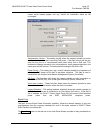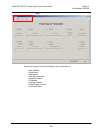
PANDUIT® DPoE™ Power Patch Panel User’s Guide Issue 2.2
Part Number: PN378A
40
If the network operator were simultaneously configuring multiple ports, the following
screen would instead appear and any values not overwritten would be left
unchanged.
Administration Control
- This setting {on/off} allows the network operator to control
whether each individual port is sourcing PoE power. If this field is set to off, the port
acts like any port on a non-powered patch panel rather than a PoE port. This
enables the network operator to mix non-powered or locally powered devices in the
same panel as PoE devices. The factory default setting for this field is ON.
Power Priority
- This setting {low, high, critical} indicates whether the importance of
maintaining PoE power to this port in low-power situations. This field is used in
coordination with a higher-level Network Management System (if available).
PD Type
- This free-form field allows the network operator to enter information on
the Powered Device (PD), such as the type of device (IP-phone, camera etc.).
Work Area Location
- These free-form fields allows the network operator to enter
information such as the location where the device is located.
Legacy Detection
– This setting {enabled, disabled} allows the network operator to
specify whether this port is connected to a Cisco legacy PoE device. If this field is
set to enabled, the
DPoE™ Power Patch Panel port will transmit Cisco-standard
power rather than the IEEE 802.3af-2003 compliant power.
Export Log
This task, like the Export Panel Information capability, allows the network operator to copy the
Log Messages from the currently selected port, rack or the entire network of
DPoE™ Power
Patch Panels to an external file.
The
Export Log button on the tool bar on the View Panel Screen provides an easy mechanism to
perform this task.


















